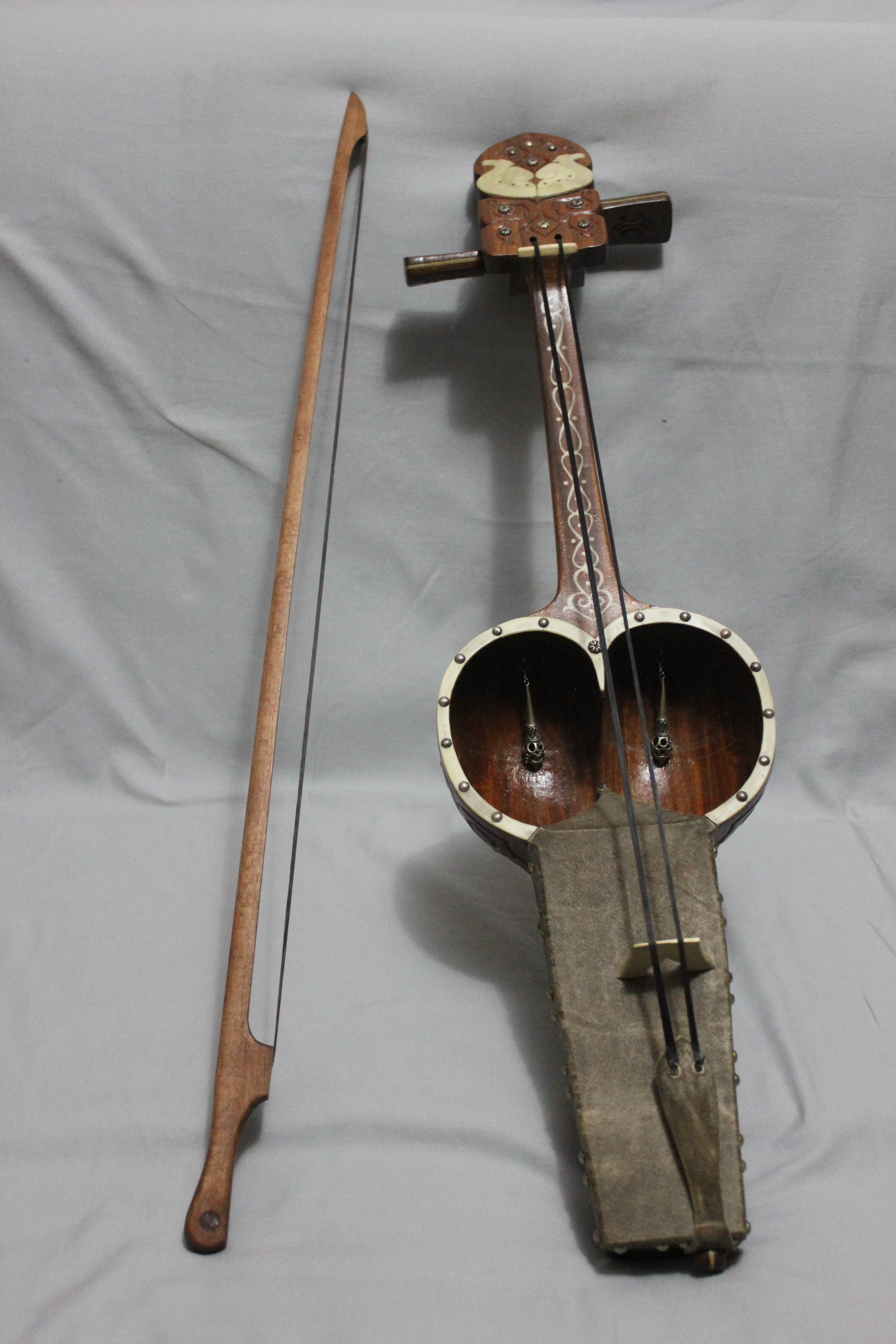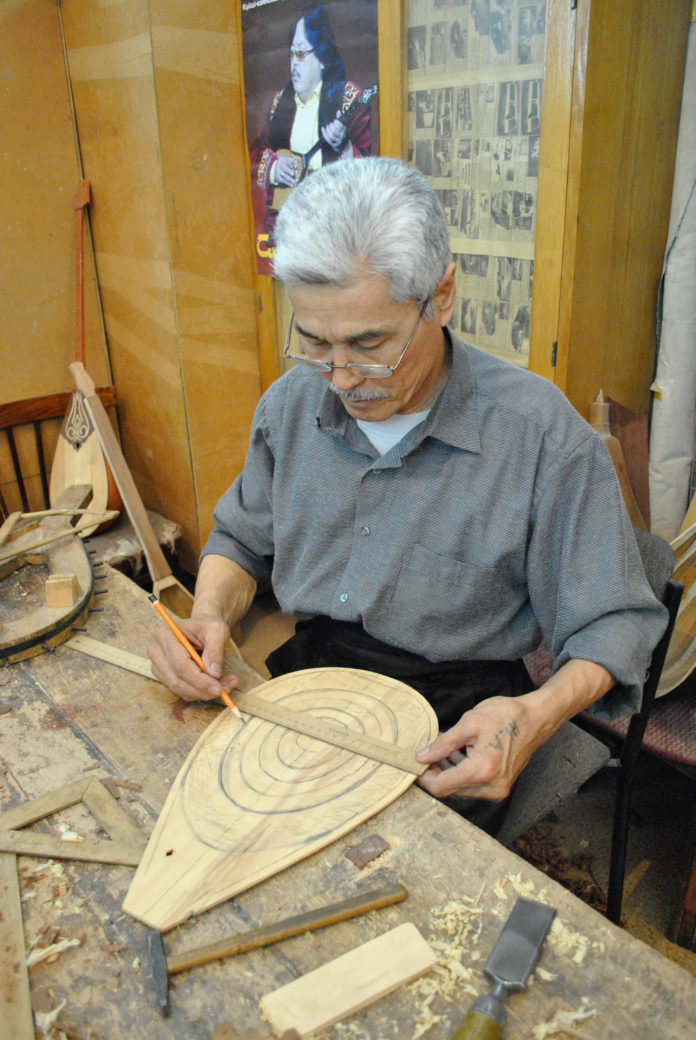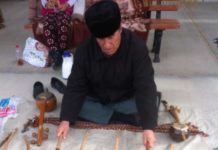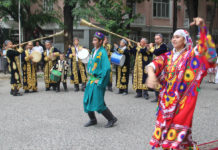One of the most widespread crafts in Kazakhstan is musical instrument making. Kazakhs produce a great diversity of folk musical instruments. There are more than 60 different types of musical instruments that fall into the following groups: chordophones (string instruments), aerophones (wind instruments), membranophones (membrane instruments, percussions), and idiophones (self- sounding instruments).
In old times musical instruments were used by Kazakh shamans (kylkobyz with mirrors and metal ringers, dangyra, asatayak); shepherds (sybyzgy, sherter, kos syrnai, kamys syrnai); hunting (bugyshak, dauylpaz, shyndaul); warriors (dudyga, shyn, muiz syrnai, kernei, uran, dabul); children (saz symai, uskirik, tastauk, konyrau, shankobyz); and musicians (dombra, kylkobyz, zhetygen, kepshik, sybyzgy).

The most popular instrument is dombra. Due to its wide distribution, it comes in many local varieties that differ in shape, fingerboard length and frets. Usually dombra has two strings, but a three and four-stringed dombra also can be found in the eastern parts of Kazakhstan.
There are several types of wood that possess tonal properties that make them good choices for use in building a dombra. It can be carved from one piece of wood (maple, birch, pear trees), or assembled from several different wood pieces because of the nature of their properties required by the different parts of the instrument (larch, walnut, juniper (arsha), mahogany). Nominally, dombra has three parts: body, neck and head. The body of a dombra consists of arched back section that can have 7, 9, or 11 facets, sounding board with a soundhole, a “button” to hold strings and movable pressure bridge that is held in place by the downward force of the tensioned strings. The neck and head (pegblock) are carved from a single piece of wood, the two sections divided by an inserted wooden nut (a raised ridge). The neck with frets inlayed into the fingerboard has a 1.5 or 2-octave range. The pegblock has 2 pegs. Modern dombra has standard dimensions: the body does not exceed 40 cm, the neck measures 48 cm, and the head is 10 cm. There are dombras for grownups (standard size) and kids (the size can vary depending on the age and height of a child).
The art of building a has two traditions originated in (1) Western and (2) Eastern, Southern and Central Kazakhstan. These traditions were influenced by the music styles popular in those regions: fast and dynamic tokpe-kyui (kyui – musical composition) in the Western Kazakhstan and melodic song style of shertpeh-kyui in Eastern, Southern and Central Kazakhstan.
The khauakh dombra from the Western Kazakhstan has a thin and long neck with 13-14 frets, 2 strings and a 2-octave range. It allows performing masterly tokpe-kyui when the sound is extracted on both strings with strong hand movements (khagyp oynau). The Eastern Kazakhstan khalakh dombra has a shorter fingerboard with 7-9 frets and a diapason of 1.5 octaves, which is ideal to play shertpe-kyui with soft plucking of strings with certain fingers. Khalakh dombra can have two, three or four strings.
There are many other folk instruments that are hollowed out of one whole wooden piece or built by individual components which must be assembled. Namely, these Kazakh traditional instruments include but not limited to sherter, kobyz, zhetygen, sazgen, khonyrau,khol-dabyl, dudyga, tokyldakh, astayakh, uuldek, many others. Musical instruments are decorated with carved patterns, inlay (bone, metal, fine wood) or painting.
Today folk stringed musical instrument makers are Zh. Turdygulov, A. Kumarov, Ye. Abilov, A. Moldahanov, N. Ohanov, Azat and their students A. Mustafayev, B. Moldabekov, M. Zhapabayev, D. Minsharypov, N. Orynbassarov, D.T. Zhanassylov, G. Zhumabayev, Ye. Rahimbek.
The most popular wind instrument is saz syrnai,an ocarina-type flute made of fired clay. It was reconstructed by B. Sarybayev and introduced in the Kazakh folk orchestra. This instrument is made in the form of a bird or an animal and has 6 tone holes. Uskirik and uyildik are similarly made but have only 2-3 tone holes. These are children’s instruments used to imitate the voices of birds and animals in addition to playing simple tunes.
Kazakh folk wind instruments are made by the following artisans: Zh. Telkozhayev, K. Tulenov, Zh. Talasov, A. Ryspayev, K. Kabdolov, and musicians at the The Kurmangazy Kazakh National Conservatoire A. Bakiya and Ye. Mukushev.
Recently the making of uran, a wind musical instrument used by warriors for signaling, was revived by a young woodcarver M. Zhapabayev.





